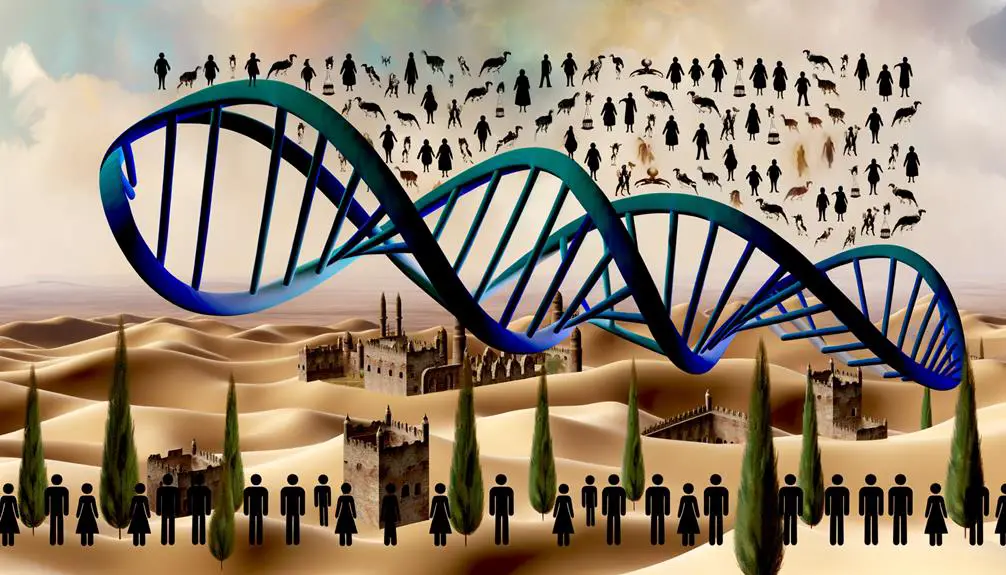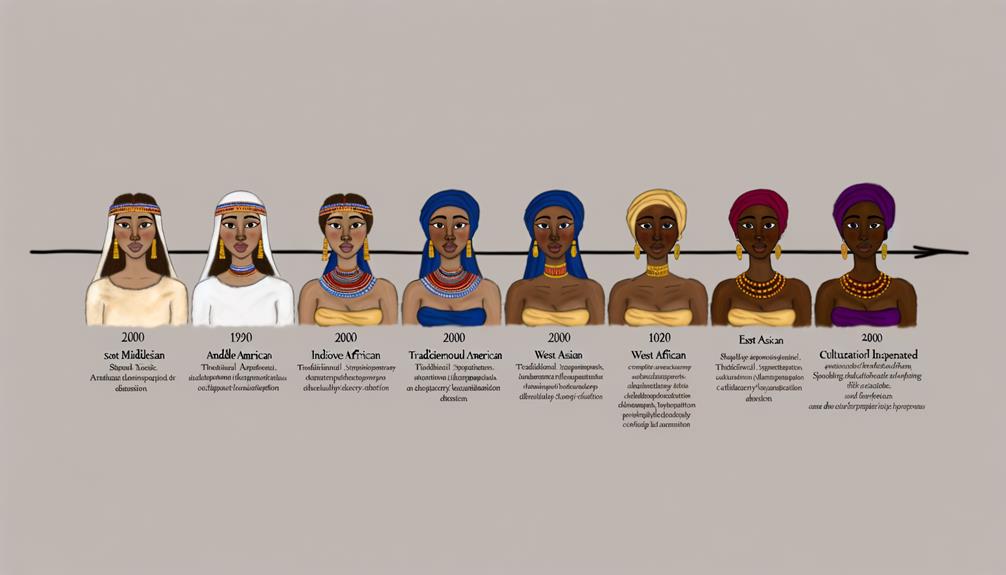Unveil the mystery of Sarah's skin color in the Bible, a topic shrouded in historical intrigue and scholarly debate.

What Color Was Sarah in the Bible
Navigating through the hues of Sarah's skin in the Bible is like walking through a mist-filled path; it's intriguing yet shrouded in mystery. You'll find that the text itself offers no clear palette, leaving her skin color to the imagination and scholarly inference.
By considering her historical context, the ethnic origins of ancient Hebrews, and the role of genetics, you're stepping into a realm where archaeology and theology intersect. Cultural depictions and scholarly debates further color this discussion, inviting you to explore the shades of understanding that have evolved over centuries.
This journey promises insights not just into Sarah's possible appearance, but into the very fabric of biblical interpretation.
Key Takeaways
- Biblical texts do not specify Sarah's skin color, reflecting sparse details on physical appearances.
- Cultural and historical context suggests Sarah likely resembled the ancient Hebrews, with Middle Eastern ethnic origins.
- Artistic depictions of Sarah vary, often influenced more by the artist's cultural background than historical accuracy.
- Understanding Sarah's appearance requires considering the ethnic diversity and migration patterns of ancient Mesopotamian societies.
Sarah's Historical Context

To understand Sarah's significance in biblical narratives, it's essential to examine her historical context within the patriarchal society of ancient Mesopotamia. This setting, deeply rooted in male dominance, shaped Sarah's personality and her religious significance. You'll find that she wasn't just a passive figure; her actions and decisions were pivotal within the scope of her time and the unfolding of biblical events.
Sarah's personality emerges as complex against the backdrop of her era. It's marked by resilience and a profound ability to navigate the challenges of her society. You see, in a time when women's roles were severely limited, Sarah stood out. Her influence on Abraham, her husband, highlights her significance beyond mere childbearing, which was a primary expectation for women then. This influence directly impacts the narrative of monotheism in its infancy, illustrating her pivotal role in religious history.
Moreover, Sarah's religious significance can't be understated. She's not just another character in the biblical text; she's foundational to the Abrahamic faiths. Her story exemplifies themes of faith, promise, and the enduring strength of the human spirit. Through her, the concept of a matriarchal figure in a patriarchal society is introduced, providing a nuanced understanding of gender roles and the divine plan in ancient texts.
In analyzing Sarah's historical context, you gain a deeper appreciation for her role in shaping the religious landscape. Her personality and the significance attributed to her actions offer rich insights into the interplay between gender, society, and faith in ancient times.
Biblical Descriptions and Insights

You'll find that the Bible provides sparse yet intriguing details about Sarah's appearance and the cultural context from which she originates.
These descriptions, coupled with historical and archaeological insights, allow for a nuanced understanding of her physical characteristics within her time period.
Sarah's Physical Descriptions
Despite the scarcity of explicit physical descriptions in biblical texts, insights into Sarah's appearance can be inferred through careful analysis of the narratives in which she features. The examination of Sarah's attire and modern comparisons sheds light on her possible physical appearance, guided by the following points:
- The *richness* of Sarah's attire, suggesting a status that could afford fine materials, often reserved for the nobility.
- *Cultural attire* norms of her time, providing clues to her daily appearance.
- *Jewelry and adornments* mentioned in passing, indicating her social standing and personal aesthetics.
- *Comparisons with contemporary figures* in similar regions, offering a speculative look at her features and style.
This analytical approach helps paint a more detailed picture of Sarah, piecing together her likely appearance from historical and textual clues.
Cultural Context Interpretations
Within the cultural context of the biblical era, Sarah's narratives offer profound insights into her societal role and personal identity, as inferred from descriptions and subtle allusions scattered throughout the texts. These accounts, filtered through epochs of translation and interpretation, shape modern perceptions of her.
Notably, Sarah's portrayal in artistic representations often reflects contemporary societal norms more so than historical accuracies, illustrating how interpretations evolve. This discrepancy between the biblical description and artistic depictions underscores the significance of understanding cultural context when analyzing biblical figures.
It's crucial to recognize that these narratives aren't just ancient texts but are also influenced by the lenses through which we view them, thus affecting our comprehension of biblical characters' identities, including Sarah.
Ethnic Origins of Ancient Hebrews

You'll find that understanding the ethnic origins of ancient Hebrews necessitates a comprehensive examination of Hebrew ancestry and lineage.
This inquiry not only sheds light on ancient Hebrew cultural identity but also influences interpretations of biblical descriptions.
Through scrutinizing historical records and biblical texts, one can appreciate the complexity of this civilization's heritage.
Hebrew Ancestry and Lineage
Exploring the ethnic origins of ancient Hebrews unveils a complex tapestry of ancestry and lineage deeply rooted in the Near Eastern region. The genealogical records and familial traditions of the Hebrews provide a rich source of information, illustrating a diverse heritage that stretches back millennia.
In examining their lineage, consider these key points:
- The significance of genealogical records in tracing Hebrew ancestry
- The role of familial traditions in preserving Hebrew identity
- Migration patterns that influenced Hebrew genetic diversity
- Interactions with neighboring cultures and their impact on Hebrew lineage
Through a detailed analysis of these factors, you'll gain insight into the multifaceted nature of Hebrew ancestry and lineage, highlighting the intricate connections between historical movements, cultural interactions, and the preservation of identity across generations.
Ancient Hebrew Cultural Identity
Delving into ancient Hebrew cultural identity reveals a deeply ingrained connection to their ethnic origins, often reflecting a rich tapestry of beliefs, traditions, and social practices that have significantly shaped their collective experience throughout history.
You'll find that clothing styles among the ancient Hebrews weren't just about aesthetics; they were a direct reflection of their societal roles, religious observances, and climatic adaptations, blending practicality with symbolism.
Similarly, their dietary habits were deeply rooted in religious commandments and agricultural cycles, showcasing a profound respect for the natural world and dietary laws that distinguished them from neighboring cultures.
This intricate interplay between clothing styles and dietary habits underscores a broader cultural ethos centered around community, faith, and a profound connection to the land, painting a vivid picture of their daily lives and spiritual observances.
Biblical Descriptions and Interpretations
Building on the understanding of ancient Hebrew cultural identity, it's crucial to examine biblical descriptions and interpretations that shed light on the ethnic origins of the Ancient Hebrews. This exploration not only enriches our comprehension of Sarah's legacy but also underscores its modern relevance.
- Biblical narratives often focus more on spiritual lineage than on physical descriptions, leaving room for various interpretations.
- Ancient texts and archaeological findings suggest a diverse ethnic composition within the Hebrew population.
- Sarah, as a matriarch, embodies more than just a personal story; she represents the shared heritage of a people.
- Understanding the ethnic origins of Ancient Hebrews helps contextualize Sarah's story within the broader tapestry of human history, enhancing its significance for contemporary audiences.
The Role of Genetics

Understanding the role of genetics in biblical times sheds light on the physical characteristics of figures like Sarah, providing a more nuanced view of historical accounts. When you delve into the study of genetic markers and modern genetics, you're embarking on a journey that bridges the past with the present. These scientific tools allow you to trace lineage and heritage, offering insights into the demographic movements and genetic predispositions of ancient populations.
Genetic markers, particularly mitochondrial DNA passed from mother to offspring, and Y-chromosome DNA, which is passed from father to son, are pivotal in reconstructing the genetic makeup of historical figures. Modern genetics, with its advanced sequencing technologies, can now identify these markers with remarkable precision. This means that, theoretically, if samples from Sarah's time were available, scientists could determine her genetic ancestry and, by extension, her likely physical characteristics.
Genetic Component |
Insight Provided |
|---|---|
Mitochondrial DNA |
Maternal lineage and ancestry |
Y-chromosome DNA |
Paternal lineage and ancestry |
Autosomal DNA |
Broader genetic makeup including traits |
Phenotypic Traits |
Physical characteristics (e.g., skin color) |
This table paints a picture of how different components of DNA contribute to our understanding of ancestral genetics. It's important to remember that while genetics can offer clues, the interpretation of these findings is subject to the limitations of current scientific methods and the availability of ancient DNA samples. Nonetheless, this approach opens up a fascinating window into the heritage and appearance of biblical figures, like Sarah, grounding their stories in the reality of human biology and history.
Archaeological Evidence

Turning our focus to archaeological evidence, one finds that it plays a crucial role in piecing together the historical context surrounding figures like Sarah from the Bible. This evidence, while not directly revealing Sarah's color, enriches our understanding of her era and environment, indirectly informing us about the lifestyle and potentially the ethnicity of people from her time.
When examining archaeological findings, several aspects stand out:
- Pottery analysis: This method provides insights into the daily life and trade networks of ancient societies. By studying the pottery styles, origins, and contents, archaeologists can infer the cultural influences and interactions between different groups. Such analysis can hint at the diversity within communities, including those Sarah might've been a part of.
- Construction techniques: The architectural remnants from Sarah's time, including homes, public buildings, and places of worship, reveal much about the people's skills, resources, and aesthetic preferences. These constructions often reflect the socio-economic status and cultural affiliations of their builders and users, offering clues about the community's composition.
- Settlement patterns: By mapping where people lived and how they organized their communities, archaeologists can deduce migration patterns, social structures, and even climate conditions. This helps to understand the environmental and social context in which Sarah lived.
- Burial practices: The way people treated their dead, including grave goods and burial rites, can indicate beliefs, social hierarchies, and ethnic identities. While direct evidence about Sarah might be elusive, the burial customs of her time can provide background on her community's cultural milieu.
Analyzing these archaeological aspects allows us to construct a more detailed picture of Sarah's time, contributing to our understanding of her historical and cultural context without directly addressing her physical appearance.
Cultural Depictions Through Ages

Throughout history, cultural depictions of Sarah have evolved, reflecting the changing societal, religious, and artistic landscapes of the times. Initially, you'll find that early representations in religious texts and artifacts leaned heavily towards a symbolic portrayal, emphasizing her role and virtues over physical appearance. As time progressed, however, and especially with the Renaissance's deep dive into biblical themes, artists began to interpret Sarah's image with more creative liberty, introducing a spectrum of physical attributes that mirrored the artists' cultural backgrounds and the aesthetic standards of their times.
This evolution can be seen as a move from the abstract to the concrete, where Sarah's identity and color became a canvas for broader societal narratives. In the modern era, interpretations of Sarah have diversified even further, thanks to a growing awareness of historical context and a push for inclusivity in storytelling. Modern interpretations often challenge traditional views, offering artistic renditions that seek to reconcile biblical accounts with contemporary understandings of race, ethnicity, and beauty.
Artistic renditions in the 21st century are particularly notable for their variety, with some artists depicting Sarah through a lens that emphasizes her Middle Eastern roots, while others may take a more symbolic approach, focusing on her spiritual significance rather than historical accuracy. This shift is part of a larger trend in art and literature that values multiple perspectives and encourages viewers to consider the complex interplay of identity, culture, and faith that characterizes biblical figures like Sarah.
In analyzing these depictions, it's clear that Sarah's portrayal is less about pinpointing her exact color and more about exploring her multifaceted identity through the ages.
Scholarly Interpretations and Debates

Building on the evolving cultural depictions of Sarah, scholars have engaged in rigorous debates regarding her historical and ethnographic identity within biblical contexts. These discussions haven't only revisited ancient texts but have also incorporated modern perspectives, aiming to understand Sarah's role and representation in both historical and theological frameworks.
Key points of debate include:
- The Historical Accuracy of Descriptions: Scholars question whether descriptions of Sarah in ancient texts reflect historical reality or serve theological purposes.
- Ethnographic Identity: Attempts to pinpoint Sarah's ethnic background have led to varied interpretations, highlighting the complexities of defining identity in ancient times.
- Theological Implications: The discussion extends to how Sarah's perceived color and ethnicity influence modern theological perspectives and interpretations of biblical narratives.
- Modern Relevance: Debates also focus on the relevance of Sarah's identity in contemporary discussions about race, ethnicity, and spirituality.
These scholarly debates are marked by a blend of historical inquiry and theological reflection. They underscore the challenge of interpreting ancient texts through a modern lens, where historical data and modern sensibilities intersect. Scholars strive to balance respect for the text's historical context with an understanding of its theological implications, all while navigating the sensitivities of modern readers.
This analytical journey reveals as much about contemporary values and beliefs as it does about Sarah's time, inviting a richer, more nuanced understanding of biblical figures and their impact on faith and identity today.
Frequently Asked Questions
How Has the Portrayal of Sarah's Color Influenced Modern Fashion and Design Trends?
You've noticed how fashion inspiration often dives into historical and biblical narratives, drawing on color symbolism to evoke certain emotions or themes. Analyzing trends, it's clear that the portrayal of figures like Sarah has subtly influenced modern fashion and design.
Designers interpret these ancient hues and motifs, weaving them into collections that resonate with historical depth. This interplay between past and present enriches our understanding of color's power in storytelling and trendsetting.
What Specific Rituals or Ceremonies in Contemporary Religious Practices Directly Reference or Symbolize Sarah's Color?
Imagine stepping into a space where every color tells a story, especially when it comes to ceremonial garments. These pieces, steeped in ritual symbolism, often draw from ancient narratives.
In contemporary religious practices, specific rituals or ceremonies incorporate colors that, while not directly referencing Sarah's color, pay homage through their symbolism. Analyzing these connections provides a deeper understanding of how tradition and interpretation intertwine, offering a rich tapestry of cultural and spiritual identity.
Can Sarah's Color Be Linked to Any Specific Dietary Habits or Preferences Mentioned in Biblical Times?
There's no direct link between Sarah's color and specific dietary habits or preferences in biblical times. When exploring the dietary laws and ancient nutrition mentioned in the Bible, you won't find references tying them to her skin color.
The focus is more on the broader cultural and religious practices, not individual traits. It's important to distinguish between personal characteristics and the general dietary guidelines followed by communities in biblical narratives.
How Do Contemporary Artists and Musicians Incorporate the Theme of Sarah's Color Into Their Works?
You're diving into a realm where Sarah's influence transcends time, captivating contemporary artists and musicians. They weave her essence into their works through enigmatic artistic interpretations.
It's not just about color; it's about the depth of her character, the stories she inspired. As you explore these creations, you'll uncover layers of meaning, each piece a testament to Sarah's enduring legacy.
This isn't merely art; it's a scholarly quest, revealing insights with every brushstroke and note.
Has the Discussion of Sarah's Color Impacted Modern Legal or Political Debates in Any Significant Way?
You might find it intriguing how discussions on color symbolism, especially in historical or biblical contexts, have barely touched modern legal or political debates directly.
Yet, the underlying themes, like those encapsulated by Sarah's story, subtly influence political symbolism and discourse.
These debates often revolve around broader issues of identity, representation, and historical interpretation, rather than the specific colors associated with biblical figures, making the impact less direct but still palpably significant in shaping contemporary views.
Conclusion
In analyzing Sarah's historical context, ethnic origins, and the role of genetics, one fascinating statistic emerges: studies estimate that ancient Hebrews, including figures like Sarah, likely had a genetic makeup similar to modern Middle Eastern populations.
This insight, alongside archaeological evidence and cultural depictions, challenges and enriches our understanding of biblical figures. Scholarly interpretations and debates continue to evolve, underscoring the complexity of reconstructing historical identities.
Thus, the quest to pinpoint Sarah's exact appearance remains an intriguing, albeit elusive, endeavor in biblical scholarship.



Sign up